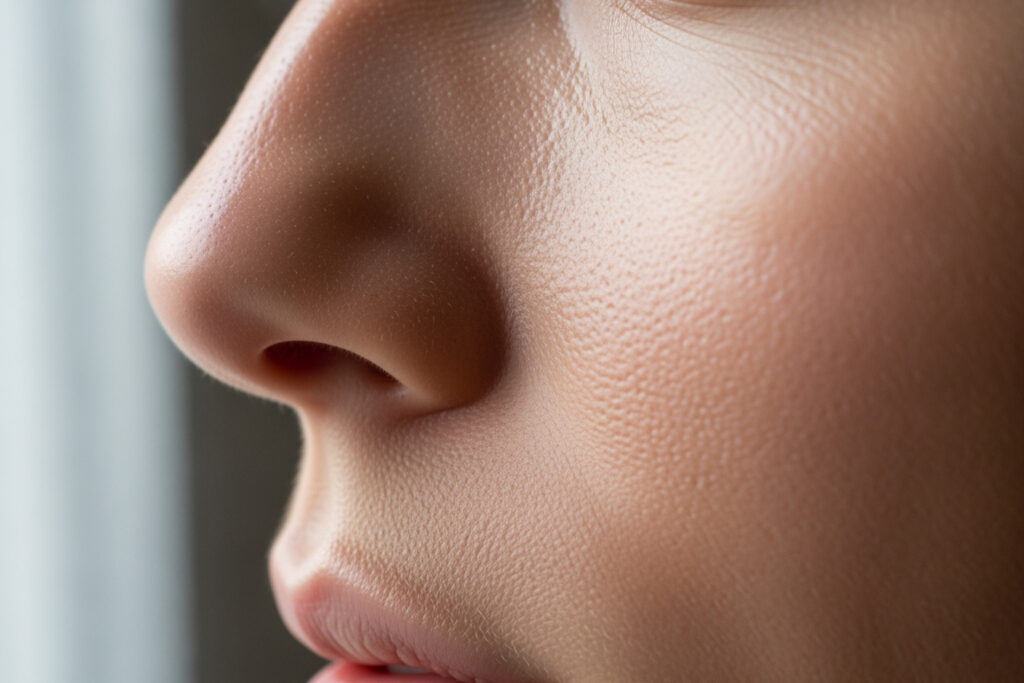Why Pores on Your Cheeks and Nose Look So Noticeable
How to minimize pores on cheeks and nose is one of the most common skincare concerns, and the good news is that you have more control than you think. While you can’t permanently shrink your pores (their size is mostly genetic), you can dramatically reduce their appearance through the right skincare routine and professional treatments.
Quick solutions to minimize pore appearance:
- Cleanse twice daily with a gentle, non-comedogenic cleanser
- Use salicylic acid (BHA) 2-3 times per week to unclog pores
- Apply clay masks 1-2 times weekly to absorb excess oil
- Moisturize with oil-free products to prevent overproduction of sebum
- Use sunscreen daily (SPF 30+) to prevent collagen breakdown
- Try retinol products at night to boost skin renewal
Pores are tiny openings in your skin that release oil and sweat. They’re most noticeable on your cheeks and nose because this T-zone area has more oil-producing glands concentrated there. When pores get clogged with excess oil, dead skin cells, and debris, they appear larger and more prominent.
The center of your face naturally has larger pores due to higher sebum production, which is why many people struggle with enlarged pores specifically in these areas. Age also plays a role – as you lose collagen and elastin over time, the skin around pores becomes less firm, making them look bigger.
Understanding what causes enlarged pores is the first step to minimizing them effectively. Beyond skincare products, factors like sun damage, hormonal changes, and even your cleansing technique all impact how noticeable your pores appear.
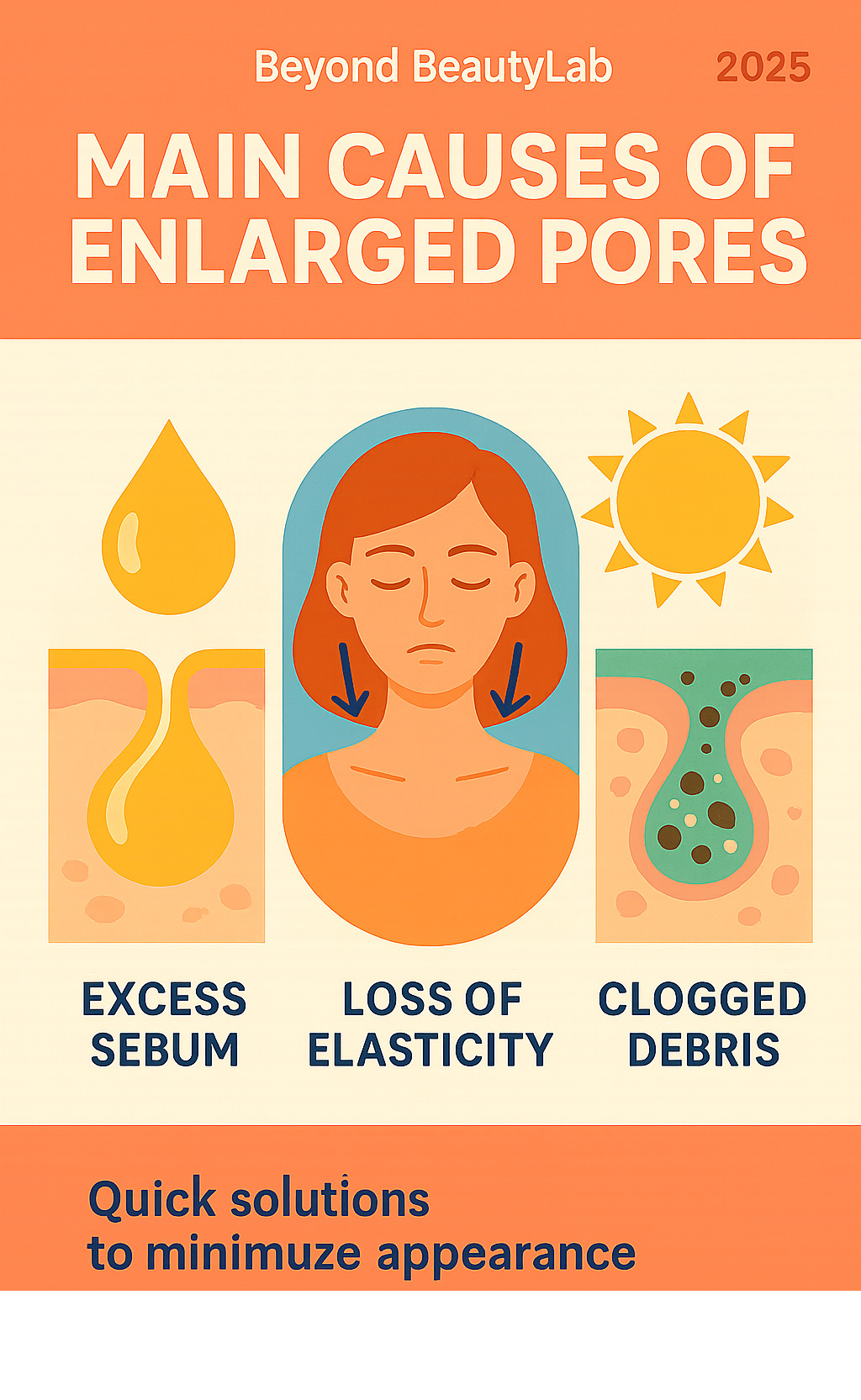
Basic how to minimize pores on cheeks and nose vocab:
Understanding Your Pores: The “Why” Behind Their Size
Pores are tiny pathways in your skin connecting to a hair follicle and a sebaceous gland. They allow your skin’s natural oil (sebum) to reach the surface, which is essential for staying moisturized and protected. This sebum production is your skin’s natural defense mechanism, helping to maintain a healthy barrier.
Genetics largely determines your baseline pore size. If your parents have larger pores, you likely will too. Your skin type is also a key factor; those with oily skin pores often find them more visible because their sebaceous glands are more active.
Aging and sun damage also contribute. Over time, skin loses collagen and elastin – the proteins that keep it firm. When this support system weakens, pores appear larger. Sun exposure, specifically UV exposure, accelerates this breakdown. Furthermore, when pores become clogged with excess oil, dead skin cells, and dirt, they physically stretch, making them more prominent. Hormonal shifts during puberty, menstrual cycles, or stress can also trigger increased oil production, worsening the effect.
Key Factors That Enlarge Pores
When we talk about learning how to minimize pores on cheeks and nose, we need to understand what’s making them look bigger in the first place.
Excess oil (sebum) is often the main culprit. Your T-zone – especially your nose and cheeks – has more oil glands packed into a smaller area. When these glands go into overdrive, they can literally stretch your pores from the inside out.
Clogged pores create a domino effect. Dead skin cells, makeup, dirt, and oil team up to form plugs that physically stretch the pore walls. It’s like stuffing too much into a small bag – eventually, the bag stretches to accommodate everything inside.
The loss of skin elasticity makes everything worse over time. Without strong collagen and elastin fibers, your skin can’t snap back to its original shape after being stretched by clogs or excess oil.
Sun damage accelerates this whole process. UV exposure breaks down your skin’s support structure faster than natural aging would, making pores appear larger sooner.
And yes, genetics still matter here too. Some people are simply born with larger pores or skin that produces more oil, making them more prone to visible pores throughout their lives.
Can You Actually Shrink Pores? The Truth vs. The Myth
A common myth is that you can “open and close” pores with water temperature. The truth is, pores don’t have muscles. Heat can soften debris for easier cleaning, and cold can cause temporary tightening, but neither changes your pore size.
Pore size is genetic, so you cannot permanently shrink them. The goal is minimizing their appearance. By keeping pores clean and supporting the surrounding skin, they become far less noticeable.
The cleaning and tightening effect from a good skincare routine is about removing the debris that stretches pores, allowing them to return to their natural size. Understanding temporary vs. long-term results is key. A clay mask offers a temporary fix, while consistent care with targeted ingredients provides lasting improvement.
While you can’t change your genetics, you have significant control over how prominent your pores look.
The Ultimate At-Home Routine: How to Minimize Pores on Cheeks and Nose
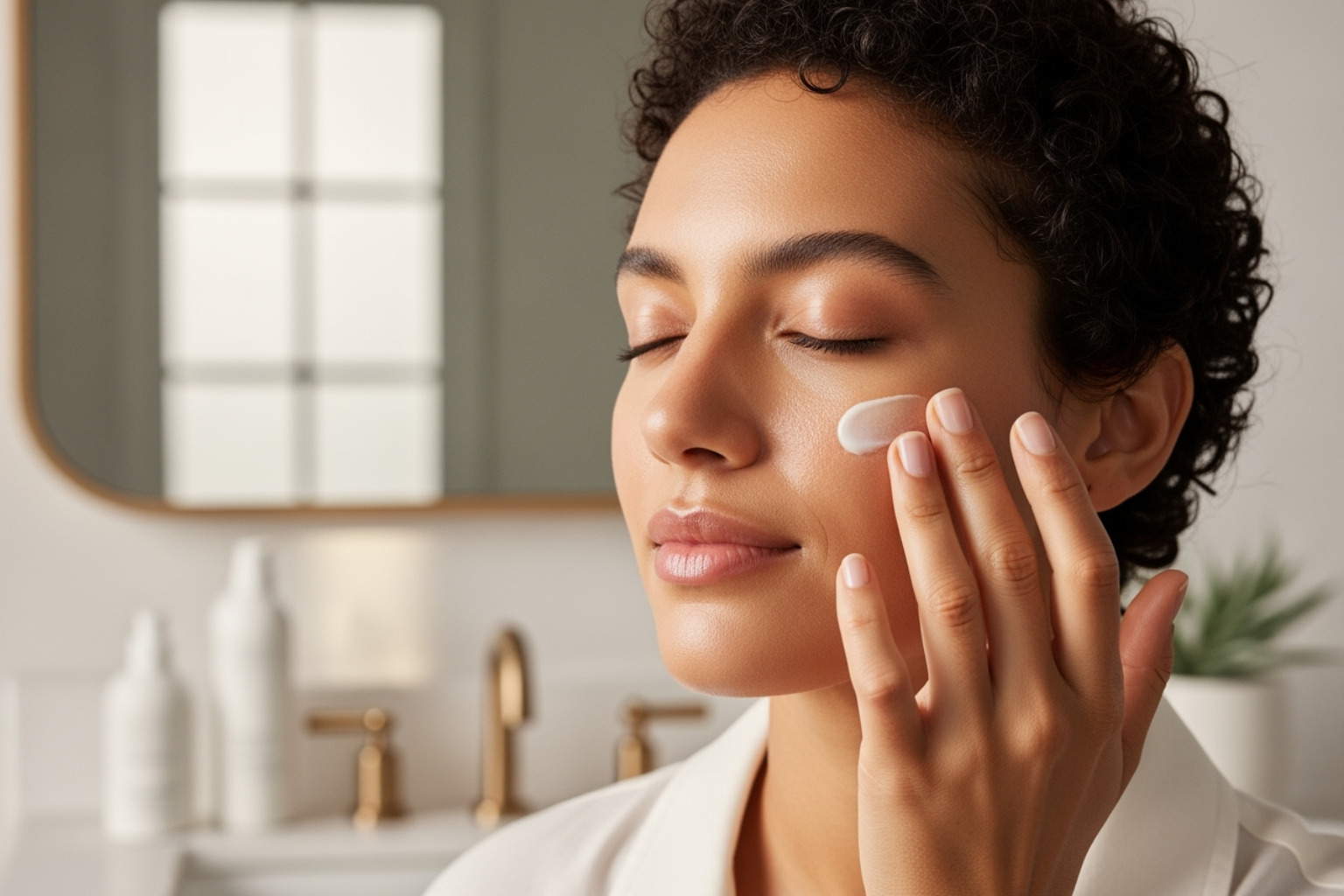
When learning how to minimize pores on cheeks and nose, a consistent routine is your best friend. You don’t need a complicated regimen; just four focused steps targeting the root causes of enlarged pores. Think of it as a daily investment in your skin’s health. A targeted approach makes all the difference, as detailed in our skincare routine for oily skin with large pores.
Step 1: Master Your Cleansing Technique
Proper cleansing gives your pores a fresh start. The American Academy of Dermatology recommends washing your face up to twice daily, and after sweating, to prevent buildup settling in. The key is to be gentle but thorough. Use lukewarm water, as hot water can strip natural oils and trigger more sebum production.
Double cleansing in the evening is a powerful technique. First, use an oil-based cleanser or micellar water to dissolve makeup and sunscreen. Follow with a gentle, water-based cleanser to remove remaining impurities, ensuring nothing is left to clog pores.
Choose non-comedogenic (won’t clog pores) and “oil-free” products, from cleansers to makeup. Gel cleansers are excellent for oily skin. Massage your cleanser for at least 30 seconds, focusing on the nose and cheeks, then pat your face dry.
Step 2: Exfoliate to Unclog and Refine
Exfoliation is crucial for pore minimization. It removes the buildup of dead skin cells and oil that creates clogs. Chemical exfoliants are particularly effective and gentle. The American Academy of Dermatology offers guidance on how to safely exfoliate at home. Aim for exfoliating 2-3 times per week.
Beta Hydroxy Acids (BHAs), like salicylic acid, are ideal for pore care. Being oil-soluble, they penetrate deep into pores to dissolve clogs, making pores appear smaller. Alpha Hydroxy Acids (AHAs), like glycolic acid, work on the skin’s surface to refine texture, which also helps reduce pore appearance.
| Feature | Alpha Hydroxy Acids (AHAs) | Beta Hydroxy Acids (BHAs) |
|---|---|---|
| Solubility | Water-soluble | Oil-soluble |
| Action | Exfoliates skin surface | Penetrates deep into pores to exfoliate |
| Best For | Dry, sun-damaged, fine lines, uneven texture | Oily, acne-prone, blackheads, enlarged pores |
| Examples | Glycolic Acid, Lactic Acid, Mandelic Acid | Salicylic Acid |
| Pore Benefit | Smooths skin, indirectly refines pore appearance | Directly unclogs pores, reduces their visibility |
Avoid over-exfoliation, which can cause irritation and make pores look larger. Start slowly and listen to your skin. For gentler options, explore our guide on natural exfoliants for smoother skin.
Step 3: Target with Powerful Ingredients
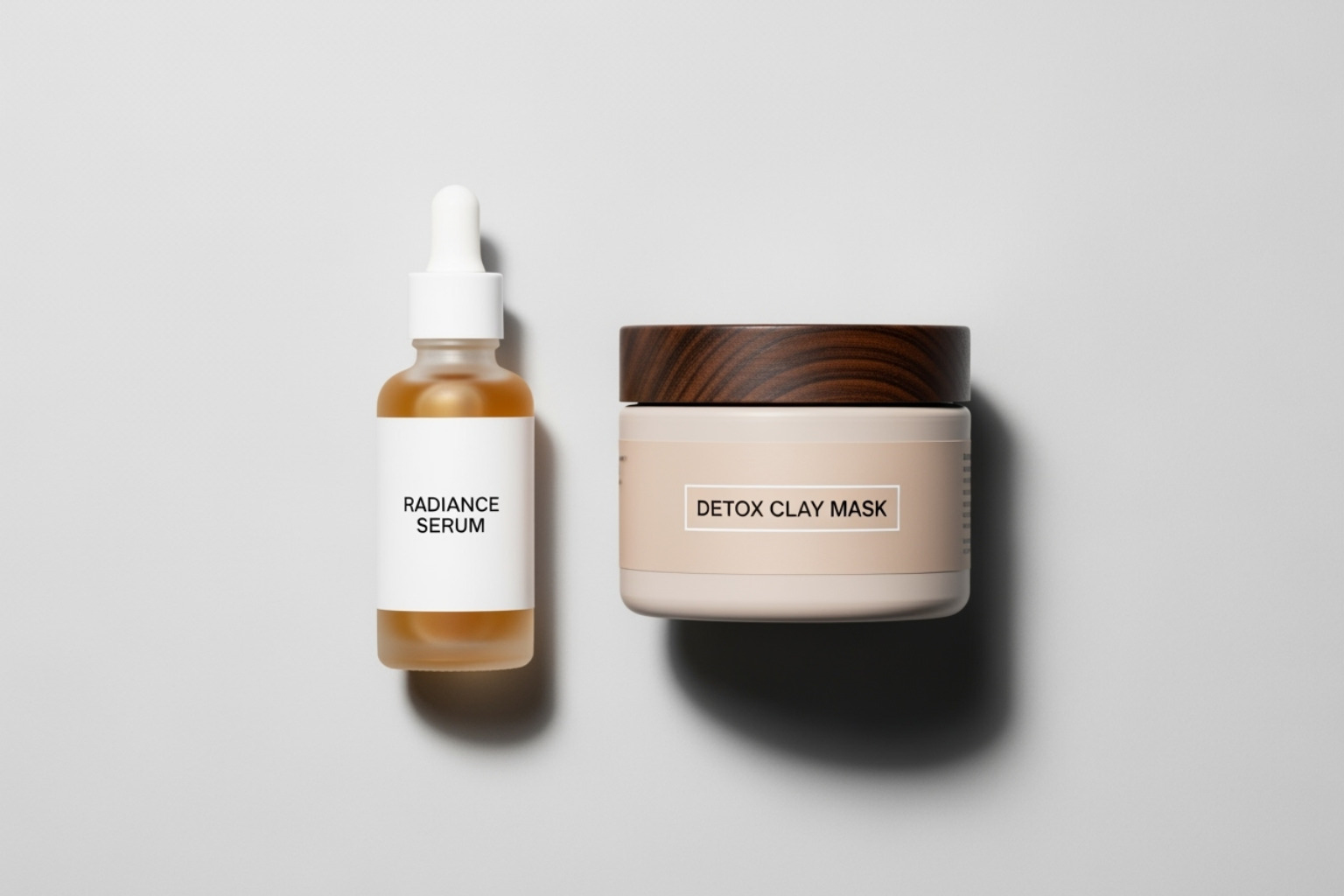
With clean pores, you can introduce targeted ingredients.
Salicylic acid is a superstar for oily, pore-prone skin, cutting through oil to keep pores clear.
Retinol and retinoids are long-term minimizers. These vitamin A derivatives reduce oil, speed up cell turnover, and boost collagen, with strong scientific evidence supporting their use. Start with twice-weekly application at night.
Niacinamide (vitamin B3) is a gentle multitasker that regulates oil and calms inflammation, keeping skin balanced.
Vitamin C acts as an antioxidant, protecting the collagen that keeps pores tight.
For instant results, use clay masks 1-2 times per week. Bentonite and kaolin clays are effective at drawing out impurities, making pores look tighter immediately after use.
Step 4: Moisturize and Protect Daily
Skipping moisturizer is counterproductive, even for oily skin. Dry skin can overcompensate by producing more oil, leading to more visible pores. Choose an oil-free and lightweight moisturizer, like a gel-based formula, to hydrate without clogging pores. Explore our recommended lightweight moisturizers for oily acne-prone skin.
Daily sunscreen use is non-negotiable. UV rays break down collagen, making pores larger over time. The American Academy of Dermatology confirms that sun exposure makes pores more noticeable. Use a broad-spectrum sunscreen with SPF 30 or higher every day to protect your skin and prevent future pore enlargement.
Beyond Skincare: Lifestyle and Makeup Tips
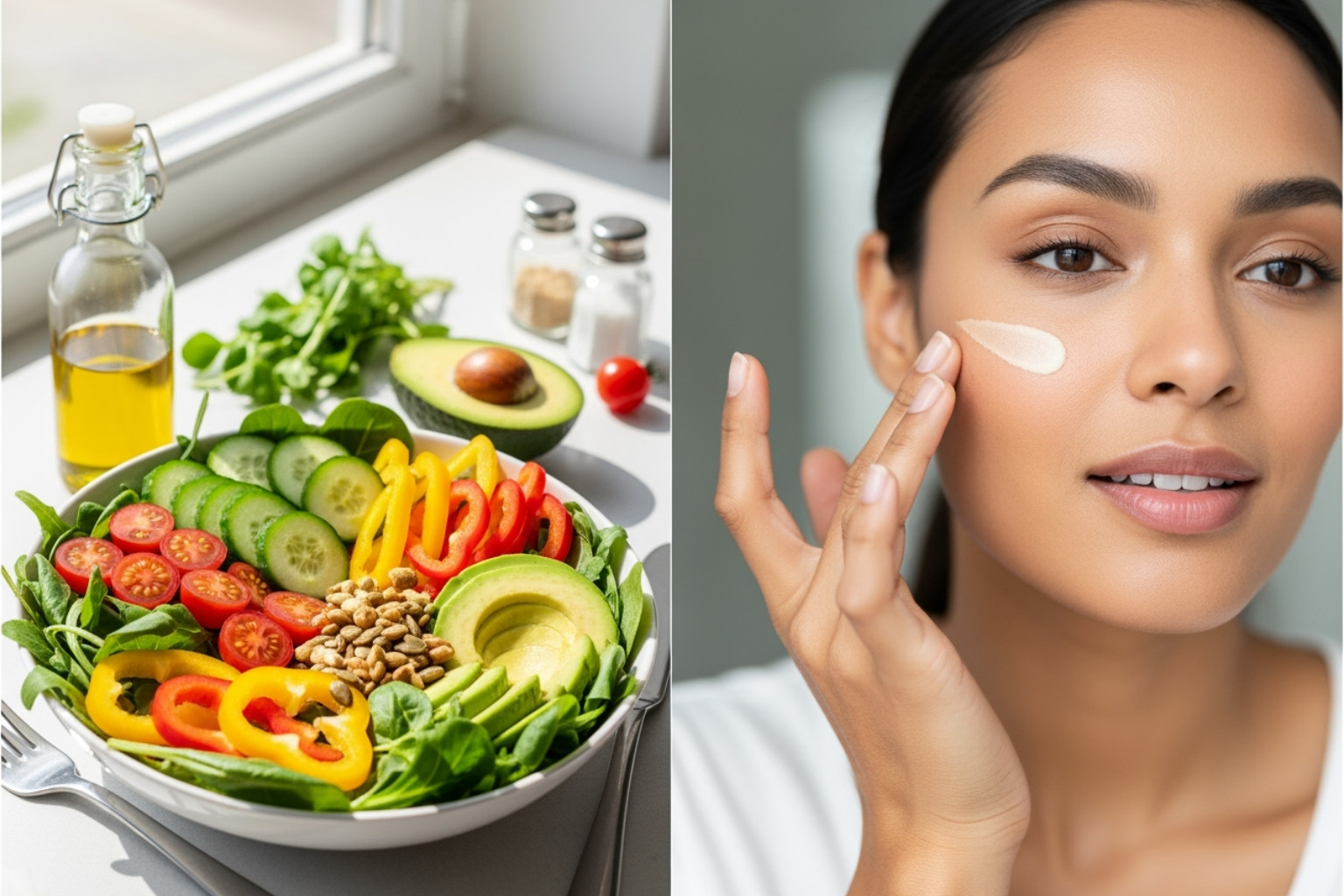
While a solid skincare routine is your foundation for how to minimize pores on cheeks and nose, a holistic approach can amplify your results. Your skin reflects your overall health, so nourishing your body and using smart makeup techniques gives your skin every advantage.
Beautiful skin isn’t just about what you put on your face – it’s also about what you put in your body. For more comprehensive guidance, check out our Beauty Tips for Clear Skin.
How Diet and Hydration Impact Your Skin
What you eat and drink shows up on your face. Staying hydrated is one of the simplest things you can do. Well-hydrated skin has better elasticity and appears plumper, making pores less noticeable. Aim for at least 8 glasses of water daily.
Foods rich in antioxidants like berries and leafy greens protect skin from damage and support healthy collagen. Think of them as bodyguards against free radicals that make pores more prominent.
Limiting processed foods and sugar can also help. High-sugar foods can trigger inflammation and increase oil production, making pores more noticeable. Many people find reducing sugar intake leads to clearer, less oily skin.
Makeup Tricks to Create a Flawless Finish
Sometimes you need immediate results, and that’s where makeup helps. With the right techniques, you can create the illusion of smoother skin in minutes.
Using a non-comedogenic primer is a game-changer. Pore-blurring primers fill in tiny depressions and create a smooth canvas for foundation, making pores seem to disappear.
When choosing the right foundation, lighter is often better. Heavy foundations can settle into pores and make them look worse. Opt for lightweight, buildable formulas. Mineral foundations are a great choice as they are less likely to clog pores.
Here’s the non-negotiable rule: always remove makeup before bed. Sleeping in makeup is one of the fastest ways to clog pores. As the American Academy of Dermatology warns, this habit can lead to serious skin problems beyond just enlarged pores.
When to See a Dermatologist: Professional Pore Treatments
Sometimes, despite our best efforts with how to minimize pores on cheeks and nose through at-home care, we need to bring in the professionals. If you’ve been diligent with your skincare routine for several months and still feel frustrated with your pore appearance, it might be time to seek expert help.
Knowing when at-home care isn’t enough can save you time and disappointment. If you have severe acne, deep scarring, or underlying skin conditions affecting your pores, a dermatologist can offer solutions that simply aren’t available over the counter. They can also help identify if other factors are contributing to your pore concerns.
Consulting a professional gives you access to stronger treatments and personalized advice based on your specific skin type and concerns. A board-certified dermatologist can assess your skin and recommend the most effective treatment plan for your situation.
The beauty of professional treatments is that they can achieve results that would take much longer with at-home care alone. However, it’s important to have realistic expectations and discuss risks and benefits thoroughly with your dermatologist before proceeding with any procedure.
In-Office Procedures for Significant Results
Professional treatments work by targeting the root causes of enlarged pores more aggressively than what’s possible at home. These procedures typically focus on deep exfoliation, collagen stimulation, or both.
Chemical peels take exfoliation to the next level. While you might use gentle acids at home, dermatologists can apply stronger concentrations that penetrate deeper into the skin. These treatments help clear pores of stubborn dead skin cells and excess oil while promoting new cell turnover. The result is smoother skin texture and visibly smaller-looking pores.
Microdermabrasion is like a professional-grade exfoliation treatment that buffs away the uppermost layer of dead skin. This procedure is particularly effective for removing the buildup that makes pores look enlarged. Many people notice an immediate improvement in skin smoothness and clarity after treatment.
Microneedling takes a different approach by stimulating your skin’s natural healing response. Tiny needles create controlled micro-injuries that trigger collagen production. As new collagen forms, it strengthens the skin structure around your pores, making them appear smaller and tighter. Research shows that microneedling can effectively improve skin texture and reduce pore visibility.
Laser therapy treatments represent some of the most advanced options available. These procedures can resurface the top layer of skin while simultaneously encouraging deeper collagen formation. Unlike topical treatments that work on the surface, laser treatments can actually alter pore structure by rebuilding the supportive tissue underneath.
The key advantage of professional treatments is their ability to provide more dramatic and longer-lasting results than home care alone. While your daily routine maintains healthy skin, these procedures can give you the significant improvement you’re looking for in minimizing pore appearance on your cheeks and nose.
Frequently Asked Questions about Minimizing Pores
What is the fastest way to learn how to minimize pores on cheeks and nose?
While there’s no overnight fix for permanently changing pore size, you can see quick visible improvements. The fastest results for how to minimize pores on cheeks and nose come from focusing on immediate pore clearance and smart cosmetic tricks.
Start with consistent exfoliation using a BHA like salicylic acid. This ingredient works deep inside your pores to clear out oil and dead skin cells. You’ll often notice a difference within a few days.
Clay masks, used a few times a week, also provide quick results by drawing out the plugs and buildup that make pores look enlarged. The results can be dramatic.
For an instant cosmetic fix, a good pore-blurring primer is magic. It fills in and smooths over pores before makeup, creating the illusion of smaller pores immediately.
Does squeezing blackheads make pores bigger?
Yes, improper squeezing can make your pores appear worse in the long run. Forcefully squeezing or picking at blackheads can traumatize the delicate pore wall, leading to inflammation, infection, and even scarring. This damage can permanently stretch the pore, making it appear larger.
It’s like stretching out a sweater; it doesn’t go back to its original shape. Chemical exfoliants are much gentler and more effective at dissolving clogs. For extractions, it’s best to see a dermatologist or licensed esthetician who can do it safely.
Can natural remedies like baking soda or egg whites really shrink pores?
While some natural ingredients provide temporary benefits, it’s important to have realistic expectations.
Egg whites, when used as a mask, create a tightening sensation as they dry, which can temporarily make pores feel tighter. However, the idea that they permanently “shrink” pores isn’t scientifically supported.
Baking soda can act as a physical exfoliant, but it’s highly alkaline and can disrupt your skin’s natural pH balance. This can lead to dryness, irritation, and potentially cause your skin to produce more oil to compensate.
While these remedies might offer temporary effects, ingredients like salicylic acid and retinol have much more scientific backing for long-term pore improvement. They are formulated to be safer and more effective for consistent use.
Conclusion
You’ve now got a complete roadmap for how to minimize pores on cheeks and nose, and honestly, that’s something to feel good about! While we can’t wave a magic wand and change our genetic blueprint (wouldn’t that be nice?), we absolutely have the power to make our pores far less noticeable.
Think of it this way: those enlarged pores that have been bothering you are mostly just stretched out from oil, debris, and time. By addressing what’s making them appear larger – that excess sebum, stubborn clogs, and gradual loss of skin bounce – you’re giving your skin exactly what it needs to look its best.
Consistency really is your secret weapon here. That gentle cleansing routine, the regular exfoliation with salicylic acid or other BHAs, those targeted ingredients like retinol working their magic overnight – each step builds on the last. And don’t underestimate the power of your daily essentials: that lightweight moisturizer keeping your skin balanced and your trusty sunscreen protecting all your hard work.
We’re not chasing some impossible pore-free fantasy (that would actually look pretty weird, if you think about it). We’re aiming for healthy, radiant skin where pores blend into the background instead of stealing the spotlight. It’s about celebrating progress, not stressing over perfection.
Your skin is unique, and finding what works best for you might take a little experimentation. That’s totally normal! At Beyond Beauty Lab, we’re here to support you with the knowledge and resources you need to feel confident in your skin. Ready to put together your perfect routine? Explore our recommended skincare products to get started, and check out our Beauty Tips for Clear and Glowing Skin for even more ways to let your natural glow shine through.

